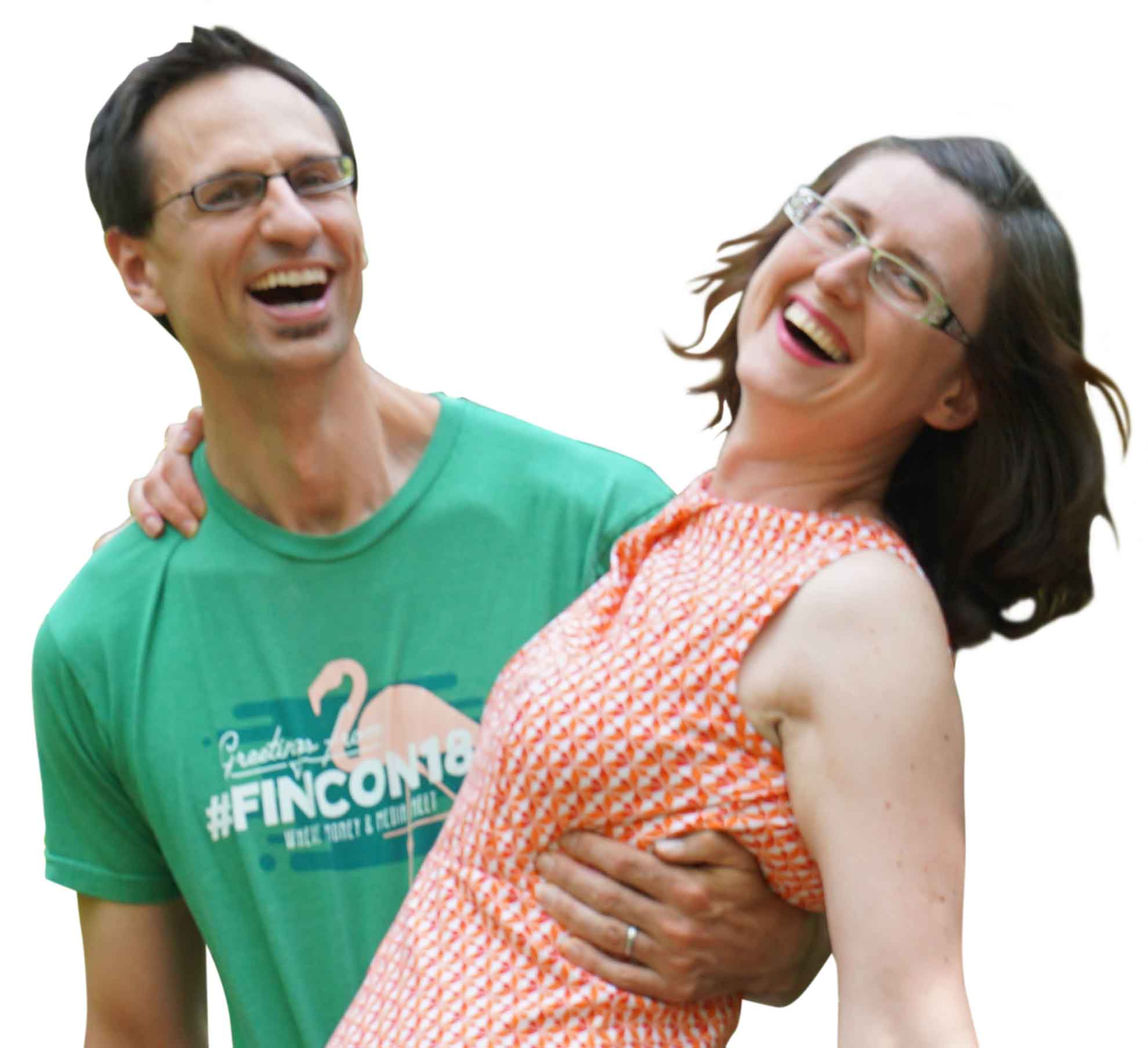This post is for the peeps early on in their career, and the awesome students who care to learn about money even while they’re neck-deep in term papers.
Let’s be honest – understanding money is a more powerful life skill than anything most of us learn in school.
I’ll show you how it’s possible to build a massive financial runway in a relatively short time – and even be in a position to pay cash for a house.
And if the thought of owning a house makes you cringe – great news!
Whether you want to travel, start a business, retire early, or whatever floats your boat – it’s about building the financial freedom to do what’s right for you!
Warning: there will be a little math in this post, but I promise to keep it fun and light – and when you’re done, you can reward yourself with the dancing squirrel video link on the bottom!
FROM $0 TO $168,000
My husband Mark will be the star of this post, exposing his finances during the first 7 years of his career. Thank you, babe!
Mark started his engineering career in 2003 at the age of 24, earning an average wage of $54,694 during the first 7 years. (For us nerds, that’s from line 1 on the W2 form, after 401k and healthcare contributions.)
Seven years after graduating, he went from $0 to $168,000 in his bank account!
That’s about $200,000 in 2018 dollars, adjusted for inflation.
Holy cow!
He had a head start by not owing student loans – so he started with zero instead of the average $18k in debt the year he graduated (today, the average student loan is closer to $40k).
Regardless of that head start, what he accomplished is extraordinary.
And it’s not black magic – this is achievable by many of us once we understand the “how” and “why”.
So did Mark get lucky with investments?
Did he live in a van down by the river, eating rice and beans?
Did he spend his weekends holed in a cave, counting his pennies?
No!
Here’s the simple, but profound secret: he used his money to do what he truly valued – not what others expected of him.
LIVING YOUR VALUES
So what did younger Mark value the most?
For those who are motivated enough to check out this video, you’ll find out quickly (hint: he’s the bass player with hair down to his waist.)
You would NEVER guess based on his current corporate haircut!
But I digress.
Here are the top three things Mark valued in his early and mid 20’s:
- Being social and having fun with friends
- Having freedom and flexibility
- Creating music and playing shows
Here’s what he did NOT value:
- Accumulating possessions
- Showing off material status symbols, such as a luxury car
- Living alone in fancy digs (because he was never there!)
And here’s what made all the blood drain from his face in terror:
- Having no savings to show for his work
- Being trapped in a job he hated
- Missing opportunities in life because of having to pay the bills
His first engineering job out of college paid $17 per hour in an oppressive workaholic culture.
Mark was overworked and underpaid like many of us.
On the weekends, he would go out with friends to try to forget about the job.
But after a few months, he realized he wasn’t saving anything – and it sent chills down his spine.
From that point, he made some drastic changes and started saving over half his income – while doing everything he valued.
He even went on 12 Caribbean cruises with his buddies, and had a fantastic time. So what did his new spending actually look like?
EXPOSED: FINANCES DURING THE FIRST 7 YEARS!
So let’s break down Mark’s expenses during the first 7 years after college (again, thank you, Mark!).
Rent + Utilities | $240 |
Auto Expenses (With Insurance) | $100 |
Gasoline | $120 |
Clothing | $30 |
Groceries | $100 |
Restaurants, Bars & Entertainment | $625 |
Vacations & Cruises | $200 |
Cell Phone | $20 |
Miscellaneous | $100 |
TOTAL MONTHLY EXPENSES | $1535 |
In other words, while working as an engineer during the first 7 years out of college, he spent about $18,420 dollars per year ($1,535 x 12).
His average salary was $54,694, and his take-home pay after taxes and retirement contributions was about $41,000.
That means he saved 55% of his take-home pay each year!!!
Total Savings
= (Take-home Pay – Annual Expenses) x Number of Years Working
= ($41,000 – $18,420) x 7
= $158,060
(I promise that squirrel video is coming!)
On top of this, he also had about $10,000 of embarrassingly low investment and interest gains, but keep in mind this was during the “Lost Decade”.
So 7 years after graduating, he had $168,000 sitting in his bank account (not counting 401k contributions)!
At the time (2009-ish), $168,000 would have been enough to pay cash for a nice house in Mark’s hometown of Columbus, Ohio – and in much of the country (New York City and such obviously excluded – that’s a whole different ball game).
Spoiler alert: he didn’t buy a house then because he didn’t need one and wasn’t interested in dealing with the expenses and time suck of home maintenance and repairs.
We only bought a house (with cash) after our first kid was born. And even then, it was bittersweet because we knew we’d be losing some of our freedom with our time.
But the bottom line is, Mark was able to put himself in a strong financial position – with an unexceptional income, and while playing in a rock band and having loads of fun!
So how did he pull this off?
WHEN SPENDING MEETS VALUES
Let’s break it down.
Housing
Quite simply, he didn’t care about fancy digs – he was never there because he was out having fun!
He rented a room from a friend for $225 per month. This bachelor pad was a blast – I still remember it because it’s where Mark lived when we met.
Before that, he paid $300 per month to live in a mansion with three divorced women. Sounds like a bad sit-com I know! (More on that in the book.)
Car
Mark definitely didn’t care about impressing people with his car.
I still remember the beat-up Cavalier he picked me up in on our first date.
But Mark understood depreciation – namely, that a new car typically loses 50% of its value 4 years after the purchase!
And so did Mark’s dad – he loved fixing up old beaters.
Mark’s dad loaned him the Cavalier he drove when we met – which Mark returned when he purchased a 1994 Honda Accord with 54,000 miles on it for $2,100.
He put another $1,000 in it – and it was still running strong 5 years and 100,000 miles later when yours truly totaled it (sorry!).
But the insurance company paid $2,800 for the car – a big win.
To this day, I’m still impressed that instead of flaunting a fancy ride, Mark told me things like, “Savings is how you jump-start your dreams.”
It was love.
Clothing
Ha! Mark still has his Metallica t-shirts from his teen years, which he sometimes wears under his shirt at work.
Food
Frankly, this area could have used improvement (to put it mildly).
Mark hardly ever cooked fresh food at home.
When I met him, his breakfast every morning was a “pig in a blanket on a stick” – a greasy sausage deep fried in pancake batter (shudder).
Enough said.
Restaurants/Bars and Vacations
Here comes the meat of it.
Right off the bat, you’ll notice that these are the two largest categories: $825 per month combined.
That’s almost $10,000 per year – over 50% of everything he spent!
He basically spent half of every dollar on going out with friends.
Wow.
But if you look back at what he valued the most at the time – friends, fun, freedom, music – this made sense.
(As a side note, Mark’s priorities have changed over time. Meaning, purpose, helping others and being of service now take center stage. Not to mention being a dad!)
Mark is so thankful that he didn’t spend his twenties burdened with debt, possessions and the need to chase status symbols – it was the lightest and freest he ever felt.
So now that we’ve dissected young Mark, what strategies helped him get to where he did?
STRATEGIES TO GET STARTED
Have you ever felt like your credit card is a money pit – where money just pours out and you have no idea where it’s going?
The young Mark dealt with this by carrying a fixed amount of cash in his wallet instead of using credit.
This was his spending limit for everything except gas because he put no limit on his freedom to travel.
It was a balancing act.
It forced him to ask “Can I afford this?” before making each purchase.
Making these small decisions every day became an ingrained habit that has naturally flowed into larger things.
It taught Mark how to maximize his enjoyment while sticking to his larger goals – and to think creatively.
He now uses credit cards almost exclusively because of the travel rewards, but this was the walking before he could run.
Sticking with cash was a useful tool, but the greatest key to Mark’s success was understanding and living his values.
Are you living YOUR values?
Doing so can put us ahead at ANY age!
Are you ready to start building incredible financial freedom and start living life on YOUR terms?
If so, start now by clicking below to get your free Values to Freedom worksheet.
Feel free to post your questions in the comments below – we’re here to help!
And finally, here’s that squirrel video I promised.



